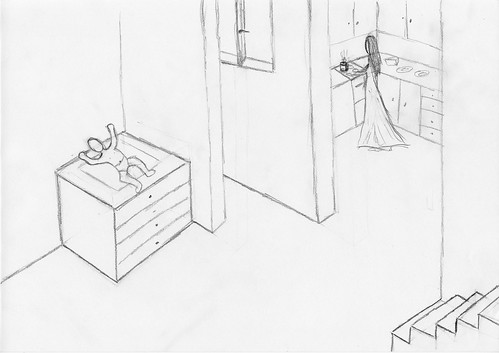 For a larger version of this go to here. And click on "All sizes"
For a larger version of this go to here. And click on "All sizes"Story of drawing.
Mother is busy in the kitchen. The baby is waiting to be taken care of. It is crying, crying and crying. The baby is noisy and needy but it does not get picked up.
It’s not mother’s fault because she is simply busy. It’s the baby’s fault.
Father is working and mother is overloaded. She is just young and has duties that she never had to deal with before. The baby is just one extra duty on a long list. The baby is not 1 year old yet. It is not an emotional priority.
Why should this baby come first. Mother was overloaded and creates a sense of guilt in the child.
It thought, “I don’t deserve to get my needs met”. “I make mother’s life harder, it would be better if I was not here”.
In terms of the fight, flight or freeze response to stress there is clearly no fight response in this case. It shows how the suicide decision can result in such circumstances as it did here. The baby does not view mother as treating it unfairly which would tend to be the fight response, “I am not being treated in the way that I should be, so its their fault” (anger).
Instead the response is to see mother as being over burdened with her domestic duties already and the baby is simply making mother’s life harder, thus it is the baby’s fault for it not being picked up. Thus it is not hard for the child to make the decision that things would be better for all concerned if it was not here. One could see this as the flight response and the feeling reaction is one of sadness and passive acceptance.

In being questioned on this scene the individual found it hard to say what her thoughts and feelings were. She stated that there were very few words and there was more feelings and noises instead. This gives the indication that the suicide decision in this case could be pre-verbal which also fits with the child being less than one year old.
If this is the case then one knows that the decisions made in this scene, including the suicide decision are going to be very resilient because they were made at such a young age before the child even had language. This implies that this individual will to some extent be potentially suicidal all her life. These very early decisions form the foundations of the personality and thus they are hard to alter through counselling compared to decisions made at older ages. The impact of the decisions can be changed but to expect them to be completely altered would be quite unusual and unrealistic. Thus there will always be a suicide decision there to some extent.

Of course a person of less than one year old can not recall such events as described and drawn here. For the purposes at hand it does not matter if it actually happened or not. These drawings and descriptions are really just visual, cognitive and kinaesthetic representations in the person’s mind, of the structure of their personality. This event describes part of the personality for instance in cognitive behavioural therapy terms, the thinking errors the person has. It does not matter if the event even occurred as it is the visual, cognitive and kinaesthetic representation the person currently holds in their mind which allows them to have consistent personality structures. It is what the person uses to actually have a personality.
I have always been surprised at how easily people will produce these early distressing scenes as well as being convinced of their authenticity. There is never a sense of people making up a story or telling a tale and so forth. Instead they produce a drawing of what they believed happened to them and as has been seen at times they can be quite elaborate and detailed. In addition the feelings and early decisions which were made as a result of the event can also be quite easily articulated.
Graffiti
Wow. That is intense. Especially, that that young of a child could make that kind of decision. What once protected her is killing her.
ReplyDeleteHer mind wants her dead. Or at least that's how I think of it. It's a fight against yourself. There's something in you that wants you dead even if you may want to live. It's so compelling, it feels like the right thing to do sometimes.
It's scary.
Hi Annalynn,
ReplyDeletethanks for showing your blog.
Yes children are making decisions right from day 1 depending on how they are treated, fed, neglected, hit, cuddled, given love and so forth.
Your comment that its a fight against yourself is exactly right when it comes to suicide. The FC wants to live and the AC wants to die. Sometimes called the suicidal ambivalence.
Cheers
Tony
I was an accident. I think i always knew it. My job was to not be annoying. But i can't seem to help it. I'm always in the way. Such is life...
ReplyDeleteBut Tony... its so nice to be alive!!
Tony,
ReplyDeleteI hope you don’t mind me asking questions about an old post. You said “children are making decisions right from day 1.” You have a video out on YouTube that I may have misinterpreted, but I thought you implied that newborn babies can be born with no will to live. Are these two statements saying the same thing? A newborn can decide it doesn’t want to live? Also, do you know at what age our memory is at least somewhat reliable?
KYLady,
ReplyDeleteYou do make some good points. On the first I think you raise the whole question of nature vs nurture. Decisions from day one is about how the enviroment effects a child's personality. And being born with no will to live is about the child's natural born temperament. If they are both about no wanting to live then one could easily have a suicdal person.
Regarding memory that is also a contentious issue that many argue about. Some say that memory is never relaible even from a month ago. It may feel relaiable but it isn't. So memory of a young childhood is likely to be very unreliable. So I can't answer your question in a clear way. I can say that I can remember my primary school and that is reliable. My memory of the quality of the relationships that I had at that age may or may not be reliable, no one will ever know.
Cheers
Tony
Tony,
ReplyDeleteThanks for answering my questions, but now you’ve really got me wondering!! Can you please explain “natural born temperament” a little more? What is the difference between personality and temperament? I think you are implying that a baby is born with temperament and personality, so these must not be the same thing.
What do you think is the temperament is of a baby who is born with no will to live? Is it that the baby is so “layed back” that breathing and eating are just too much effort, or perhaps is it that the baby is so high strung that any little thing is too upsetting and it decides it just can’t deal with it. Babies who are born in hospitals may not get to choose to die if that is their temperament. Surely we would try to force them to stay alive, and probably keep forcing health care on them for as long as the parents could afford it and wanted the child to remain alive. I think what you’re really saying here is not that the baby chooses to die, but he/she chooses not to live. We can keep people alive against their will, but if the person doesn’t want to live, that isn’t much of a life.
A final question if you have time – at what age could the baby/child be assessed and a determination be made that the baby’s temperament is an issue in its lack of desire to live?